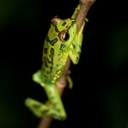|
Ghatixalus asterops Biju, Roelants & Bossuyt, 2008
| family: Rhacophoridae subfamily: Rhacophorinae genus: Ghatixalus |
| Species Description: Biju SD Roelants K Bossuyt F 2008 Phylogenetic position of the montane treefrog Polypedates variabilis Jerdon, 1853 (Anura: Rhacophoridae), and description of a related species. Organisms Diversity & Evolution 8:267-276. | |
 © 2017 Benjamin Tapley/ZSL (1 of 2) |
|
|
|
Description Coloration: Varies between localities. Dorsally, this species may have irregularly patterned brown blotches on a dark or light gray background, or reddish brown blotches on a yellowish brown background. Loreal and tympanic areas are light gray with brown spotting. Sides are yellow with brown patches. Hand and foot are light bluish-white with bluish-brown blotches present on the webbing. The posterior thigh is bluish-brown. The iris is brownish with golden stripes in the shape of a star and a slender golden ring around the periphery. Limbs are dark gray with dark brown bars. Fingers and toes are barred and have light gray tips. Juveniles: Juvenile frogs vary from light green to light brown. Adults are never green. Similar species: Distinguished from G. variabilis by the star-like eye pattern (uniform brown in G. variabilis), pointed snout (vs. oval), acute loreal region (vs. obtuse), shorter supratympanic fold extending to upper forearm (vs. extending to just below upper forearm level), and a longer shank equal to the thigh length (vs. shorter than thigh length). Distribution and Habitat Country distribution from AmphibiaWeb's database: India
Life History, Abundance, Activity, and Special Behaviors In late summer, August to September, male calling occurs after 6:00pm. Calls consist of a series of five to seven whistle-like notes (phu phu phu phu phu phu phu), repeated every two to three minutes. Amplexus is axillary. Foam nests are constructed on rocks, vertical earth surfaces of stream banks, and occasionally on the bases of trees adjacent to the stream, suspended up to 3 m above the water. The nests are spherical in shape. Eggs are white and measure 2.8 mm in diameter. Tadpoles hatch and fall into the body of water four days after egg deposition. Hatching success rate was 78.7% in 185 eggs from a single nest. Trends and Threats Possible reasons for amphibian decline General habitat alteration and loss Comments
References
Biju, S. D., Roelants, K., and Bossuyt, F. (2008). ''Phylogenetic position of the montane treefrog Polypedates variabilis Jerdon, 1853 (Anura: Rhacophoridae), and description of a related species .'' Organisms, Diversity, and Evolution, 8(4), 267-276. Originally submitted by: Jesse Lou (first posted 2009-02-12) Edited by: Kellie Whittaker (2009-03-26) Species Account Citation: AmphibiaWeb 2009 Ghatixalus asterops <https://amphibiaweb.org/species/7266> University of California, Berkeley, CA, USA. Accessed Jan 22, 2025.
Feedback or comments about this page.
Citation: AmphibiaWeb. 2025. <https://amphibiaweb.org> University of California, Berkeley, CA, USA. Accessed 22 Jan 2025. AmphibiaWeb's policy on data use. |



 Map of Life
Map of Life